应诉通知书英语
英语作文通知体裁有哪些

英语作文通知体裁有哪些在英语作文中,通知体裁可以有多种形式。
以下是几种常见的通知体裁:1. 公告 (Announcement):Announcements are used to inform a group of people about an event, a decision, or any other important information. They are usually brief and to the point.Example: "Attention All Students: School Carnival Postponed to Next Week."2. 邀请函 (Invitation):Invitations are used to invite people to attend an event, gathering, or celebration.Example: "You're Invited! Join Us for Sarah's Birthday Party on Saturday."3. 通告 (Notice):Notices are formal statements informing individuals about something of importance.Example: "Notice: Road Closure on Main Street for Repairs."4. 备忘录 (Memo):Memos are internal documents used within an organization to communicate important information or decisions to employees.Example: "Memo: Change in Office Hours Starting Next Month."5. 公开信 (Open Letter):Open letters are written to address a specific person or group of people and are often published forpublic viewing.Example: "An Open Letter to the Community: Let's Work Together to Improve Our Neighborhood."6. 通讯 (Newsletter):Newsletters are periodic publications containing news, updates, and information about a particular organization, group, or topic.Example: "Monthly Newsletter: Stay Informed About Our School's Latest Events and Achievements."7. 告示 (Proclamation):Proclamations are formal announcements issued by authorities or organizations to declare or announce something significant.Example: "Proclamation: June 5th Declared World Environment Day."这些是通知体裁的一些常见类型,每种类型都有其独特的特点和用途,具体选择哪种取决于通知的目的、受众和形式。
诉讼法律英语词汇大全
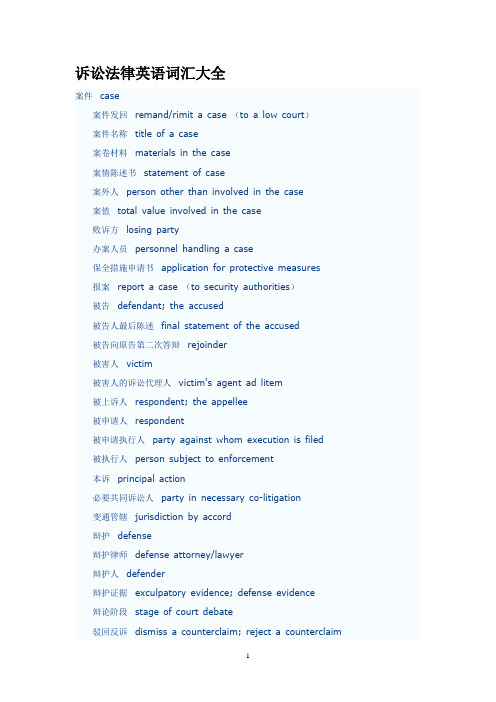
诉讼法律英语词汇大全案件case案件发回remand/rimit a case (to a low court)案件名称title of a case案卷材料materials in the case案情陈述书statement of case案外人person other than involved in the case案值total value involved in the case败诉方losing party办案人员personnel handling a case保全措施申请书application for protective measures报案report a case (to security authorities)被告defendant; the accused被告人最后陈述final statement of the accused被告向原告第二次答辩rejoinder被害人victim被害人的诉讼代理人victim's agent ad litem被上诉人respondent; the appellee被申请人respondent被申请执行人party against whom execution is filed被执行人person subject to enforcement本诉principal action必要共同诉讼人party in necessary co-litigation变通管辖jurisdiction by accord辩护defense辩护律师defense attorney/lawyer辩护人defender辩护证据exculpatory evidence; defense evidence辩论阶段stage of court debate驳回反诉dismiss a counterclaim; reject a counterclaim驳回请求deny/dismiss a motion驳回上诉、维持原判reject/dismiss the appeal and sustain the original jud gement/ruling驳回诉讼dismiss an action/suit驳回通知书notice of dismissal驳回自诉dismiss/reject a private prosecution驳回自诉裁定书ruling of dismissing private-prosecuting case补充答辩supplementary answer补充判决supplementary judgement补充侦查supplementary investigation不公开审理trial in camera不立案决定书written decision of no case-filing不批准逮捕决定书written decision of disapproving an arrest不起诉nol pros不予受理起诉通知书notice of dismissal of accusation by the court财产保全申请书application for attachment; application for property pres ervation裁定order; determination (指最终裁定)裁定管辖jurisdiction by order裁定书order; ruling裁决书award采信的证据admitted evidence查封seal up撤回上诉withdraw appeal撤诉withdraw a lawsuit撤销立案revoke a case placed on file撤销原判,发回重审rescind the original judgement and remand the case ro the original court for retrial出示的证据exhibit除权判决invalidating judgement (for negotiable instruments)传唤summon; call传闻证据hearsay答辩answer; reply答辩陈述书statement of defence答辩状answer; reply大法官associate justices; justice大检察官deputy chief procurator代理控告agency for accusation代理申诉agency for appeal代理审判员acting judge代为申请取保候审agency for application of the bail pending trial with re stricted liberty of moving弹劾式诉讼accusatory procedure当事人陈述statement of the parties当庭宣判pronouncement of judgement or sentence in court地区管辖territorial jurisdiction地区检察分院inter-mediate People's Procuratorate第三人third party调查笔录record of investigation定期宣判pronouncement of judgement or sentence later on a fixed date 定罪证据incriminating evidence; inculpatory evidence冻结freeze督促程序procedure of supervision and urge独任庭sole-judge bench独任仲裁员sole arbitrator对妨碍民事诉讼的强制措施compulsory measures against impairment of ci vil action对席判决judgement inter parties二审trial of second instance二审案件case of trial of second insurance罚款impose a fine法定证据statutory legal evidence法定证据制度system of legal evidence法官judges法警bailiff; court police法律文书legal instruments/papers法律援助legal aid法律咨询legal consulting法庭辩论court debate法庭调查court investigation法庭审理笔录court record法庭审理方式mode of court trial法庭庭长chief judge of a tribunal法院court法院公告court announcement反诉counterclaim反诉答辩状answer with counterclaim反诉状counterclaim犯罪嫌疑人criminal suspect附带民事诉讼案件 a collateral civil action附带民事诉讼被告defendant of collateral civil action 复查reexamination; recheck复验reinspect高级法官senior judge高级检察官senior procurator高级人民法院Higher People's Court告诉案件case of complaint告诉才处理的案件case accepted at complaint告诉申诉庭complaint and petition division工读学校work-study school for delinquent children 公安部Ministry of Public Security公安分局public security sub-bureau公安厅public security bureau at the levels of provinces, autonomous r egions and cities under direct jurisdiction of central government 公开审理trial in public公开审判制度open trial system公示催告程序procedure of public summons for exhortation公诉案件public-prosecuting case公诉词statement of public prosecution公证机关public notary office共同管辖concurrent jurisdiction管辖jurisdiction国际司法协助international judicial assistance海事法院maritime court合议庭collegial panel合议庭评议笔录record of deliberating by the collegiate bench和解composition; compromise核对诉讼当事人身份check identity of litigious parties恢复执行resumption of execution回避withdrawal混合式诉讼mixed action基层人民法院basic People's Court羁押期限term in custody级别管辖subject matter jurisdiction of courts at different levels监视居住living at home under surveillance监狱prison检察官procurator检察权prosecutorial power检察委员会procuratorial/prosecutorial committee检察院procuratorate检察院派出机构outpost tribunal of procuratorate简易程序summary procedure鉴定结论expert conclusion经济审判庭economic tribunal径行判决direct adjudication without sessions; judgement without notice 纠问式诉讼inquisitional proceedings拘传summon by force; summon by warrant拘留所detention house举报information/report of an offence举证责任burden of proof; onus probandi决定书decision军事法院military procuratorate开庭审理open a court session开庭通知notice of court session勘验笔录record of inquest看守所detention house可执行财产executable property控告式诉讼accusatory proceedings控诉证据incriminating evidence控诉职能accusation function扣押distrain on; attachment扣押物distress/distraint宽限期period of grace劳动争议仲裁申请书petition for labor dispute arbitration劳改场reform-through-labor farm劳教所reeducation-through-labor office类推判决的核准程序procedure for examination and approval of analogica l sentence累积证据cumulative evidence立案报告place a case on file立案管辖functional jurisdiction立案决定书written decision of case-filing立案侦查report of placing a case on file利害关系人interested party临时裁决书interim award律师见证书lawyer's written attestation; lawyer's written authentication 律师事务所law office; law firm律师提前介入prior intervention by lawyer免于刑事处分exemption from criminal penalty民事案件civil case民事审判庭civil tribunal民事诉讼civil action民事诉讼法Civil Procedural Law扭送seize and deliver a suspect to the police派出法庭detached tribunal派出所police station判决judgement; determination判决书judgement; determination; verdict (指陪审团作出的)旁证circumstantial evidence陪审员juror批准逮捕approval of arrest破案clear up a criminal case; solve a criminal case破产bankruptcy; insolvency普通程序general/ordinary procedure普通管辖general jurisdiction企业法人破产还债程序procedure of bankruptcy and liquidation of a busin ess corporation起诉filing of a lawsuit起诉sue; litigate; prosecute; institution of proceedings起诉状indictment; information区县检察院grassroots People's Procuratorate取保候审the bail pending trial with restricted liberty of moving缺席判决default judgement人民调解委员会People's Mediation Committee认定财产无主案件cases concerning determination of property as qwnerle ss认定公民无民事行为能力、限制民事行为能力案件cases concerning determinati on of a citizen as incompetent or with limited disposing capacity 上诉appeal上诉人appellant上诉状petition for appeal少管所juvenile prison社会治安综合治理comprehensive treatment of social security涉外案件cases involving foreign interests涉外民事诉讼foreign civil proceedings涉外刑事诉讼foreign criminal proceedings申请人applicant; petitioner申请书petition; application for arbitration申请执行人execution applicant申诉人宣誓书claimant's affidavit of authenticity申诉书appeal for revision; petition for revision神示证据制度system of divinity evidence神示制度ordeal system审查案件case review审查并决定逮捕examine and decide arrest审查起诉阶段stage of review and prosecution审理通知书notice of hearing审判长presiding judge审判长宣布开庭presiding judge announce court in session审判管辖adjudgement/trial jurisdiction审判监督程序procedure for trial supervision审判委员会judicial committee审判员judge审问式诉讼inquisitional proceedings生效判决裁定legally effective judgement/order胜诉方winning party省市自治区检察院higher People's Procuratorate失踪和死亡宣告declaration of disappearance and death实(质)体证据substantial evidence实物证据tangible evidence实在证据real evidence示意证据demonstrative evidence视听证据audio-visual evidence收容所collecting post; safe retreat首席大法官chief justice首席检察官chief procurator受害人的近亲属victim's immediate family受理acceptance受理刑事案件审批表registration form of acceptance of criminal case受送达人the addressee书记员court clerk书记员宣读法庭纪律court clerk reads court rules书证documentary evidence司法部Ministry of Justice司法机关judicial organizatons司法警察judicial police司法局judicial bureau司法厅judicial bureau at the levels of provinces, autonomous regions, and cities under direct jurisdiction of central government司法协助judicial assistance死缓的复核judicial review of death sentence with a retrieve死刑复核程序procedure for judicial review of death sentence死刑复核权competence for judicial review of death sentence送达service of process送达传票service of summons/subpoena送达诉状service of bill of complaint搜查search诉sue; suit; action; lawsuit诉前财产保全property attachment prior to lawsuit诉讼litigation; lawsuit; sue; action诉讼保全attachment诉讼参加人litigious participants诉讼代理人agent ad litem诉状complaint; bill of complaint; state of claim特别程序special procedures提起公诉institute a public prosecution铁路法院railway court铁路检察院railroad transport procuratorate庭审程序procedure of court trial通缉wanted for arrest投案appearance退回补充侦查return of a case for supplementary investigation 委托辩护entrusted defense未成年人法庭juvenile court无行政职务的法官associate judge无正当理由拒不到庭refuse to appear in court without due cause 无罪判决acquittal, finding of “ not guilty ”物证material evidence先予执行申请书application for advanced execution先予执行advanced execution刑事案件criminal case刑事拘留criminal detention刑事强制拘留criminal coercive/compulsory measures刑事审判庭criminal tribunal刑事诉讼criminal proceedings刑事诉讼法Criminal Procedural Law刑事自诉状self-incriminating criminal complaint行政案件administrative case行政审判庭administrative tribunal行政诉讼administrative proceedings行政诉讼法Administrative Procedural Law宣告失踪、宣告死亡案件cases concerning the declaration of disappearanc e and death宣判笔录record of rendition of judgement选民资格案件cases concerning qualifications of voters询问证人inquire/question a witness训诫reprimand讯问笔录record of interrogation询问犯罪嫌疑人interrogate criminal suspect言词证据verbal evidence要求传唤证人申请书application for subpoena一裁终局arbitration award shall be final and binding一审trial of first instance一审案件case of trial of first instance应诉通知书notice of respondence to action有罪判决sentence; finding of “guilty”予审preliminary examinantion; pretrial原告plaintiff院长court president阅卷笔录record of file review (by lawyers)再审案件case of retrial再审申请书petition for retrial责令具结悔过order to sign a statement of repentance债权人会议creditors' meeting侦查阶段investigation stage侦查终结conclusion of investigation征询原、被告最后意见consulting final opinion of the plaintiff and defenda nt证据evidence证据保全preserve evidence证据保全申请书application for evidence preservation证人证言testimony of witness; affidavit支付令payment order/warrant知识产权庭intellectual property tribunal执行程序procedure execution执行逮捕execution of arrest执行和解conciliation of execution执行回转recovery of execution执行庭executive tribunal执行异议objection to execution执行员executor执行中止discontinuance of execution执行终结conclusion of execution指定辩护appointed defense指定仲裁员声明statement of appointing arbitrator中级人民法院intermediate People's Court中途退庭retreat during court session without permission仲裁arbitration仲裁被诉人respondent; defendant仲裁裁决award仲裁申请书arbitration仲裁申诉人claimant; plaintiff仲裁庭arbitration tribunal仲裁委员会arbitration committee仲裁协议arbitration agreement; clauses of arbitration仲裁员arbitrator主诉检察官principal procurator助理检察官assistant procurator助理审判员assistant judge专门法院special court专门管辖specific jurisdiction专属管辖exclusive jurisdiction追究刑事责任investigate for criminal responsibility自首confession to justice自诉案件private-prosecuting case自行辩护self-defense自由心证制度doctrine of discretional evaluation of evidence 自侦案件self-investigating case最高人民法院the Supreme People's Court最高人民检察院the Supreme People's Procuratorate最后裁决书final award应诉通知书notice of respondence to action有罪判决sentence; finding of “guilty”予审preliminary examinantion; pretrial原告plaintiff院长court president阅卷笔录record of file review (by lawyers)再审案件case of retrial再审申请书petition for retrial责令具结悔过order to sign a statement of repentance债权人会议creditors' meeting侦查阶段investigation stage侦查终结conclusion of investigation征询原、被告最后意见consulting final opinion of the plaintiff and defenda nt证据evidence证据保全preserve evidence证据保全申请书application for evidence preservation证人证言testimony of witness; affidavit支付令payment order/warrant知识产权庭intellectual property tribunal执行程序procedure execution执行逮捕execution of arrest执行和解conciliation of execution执行回转recovery of execution执行庭executive tribunal执行异议objection to execution执行员executor执行中止discontinuance of execution执行终结conclusion of execution指定辩护appointed defense指定仲裁员声明statement of appointing arbitrator中级人民法院intermediate People's Court中途退庭retreat during court session without permission仲裁arbitration仲裁被诉人respondent; defendant仲裁裁决award仲裁申请书arbitration仲裁申诉人claimant; plaintiff仲裁庭arbitration tribunal仲裁委员会arbitration committee仲裁协议arbitration agreement; clauses of arbitration仲裁员arbitrator主诉检察官principal procurator助理检察官assistant procurator助理审判员assistant judge专门法院special court专门管辖specific jurisdiction专属管辖exclusive jurisdiction追究刑事责任investigate for criminal responsibility自首confession to justice自诉案件private-prosecuting case自行辩护self-defense自由心证制度doctrine of discretional evaluation of evidence 自侦案件self-investigating case最高人民法院the Supreme People's Court最高人民检察院the Supreme People's Procuratorate最后裁决书final award。
法律专业词汇中英对照(h,i,j,k)_法律英语词汇
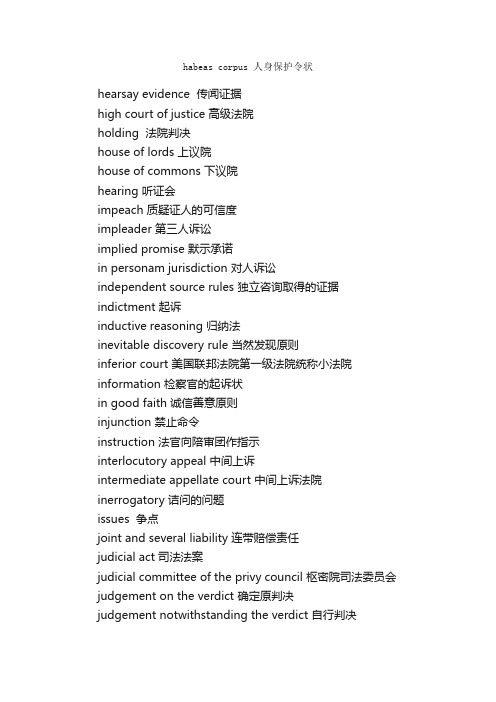
habeas corpus 人身保护令状hearsay evidence 传闻证据high court of justice 高级法院holding 法院判决house of lords 上议院house of commons 下议院hearing 听证会impeach 质疑证人的可信度impleader 第三人诉讼implied promise 默示承诺in personam jurisdiction 对人诉讼independent source rules 独立咨询取得的证据indictment 起诉inductive reasoning 归纳法inevitable discovery rule 当然发现原则inferior court 美国联邦法院第一级法院统称小法院information 检察官的起诉状in good faith 诚信善意原则injunction 禁止命令instruction 法官向陪审团作指示interlocutory appeal 中间上诉intermediate appellate court 中间上诉法院inerrogatory 诘问的问题issues 争点joint and several liability 连带赔偿责任judicial act 司法法案judicial committee of the privy council 枢密院司法委员会judgement on the verdict 确定原判决judgement notwithstanding the verdict 自行判决jurisdiction over the subjuct matter 对物诉讼jury 陪审团juvenile court 青少年法院judgement 法官作成的判决king's bench division 王室法庭king's council国王的咨询会议。
常用的法律英语术语.
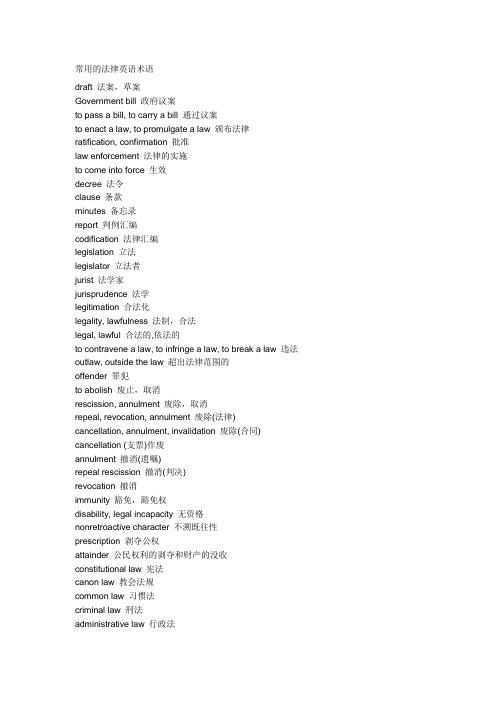
常用的法律英语术语draft 法案,草案Government bill 政府议案to pass a bill, to carry a bill 通过议案to enact a law, to promulgate a law 颁布法律ratification, confirmation 批准law enforcement 法律的实施to come into force 生效decree 法令clause 条款minutes 备忘录report 判例汇编codification 法律汇编legislation 立法legislator 立法者jurist 法学家jurisprudence 法学legitimation 合法化legality, lawfulness 法制,合法legal, lawful 合法的,依法的to contravene a law, to infringe a law, to break a law 违法outlaw, outside the law 超出法律范围的offender 罪犯to abolish 废止,取消rescission, annulment 废除,取消repeal, revocation, annulment 废除(法律) cancellation, annulment, invalidation 废除(合同) cancellation (支票)作废annulment 撤消(遗嘱)repeal rescission 撤消(判决)revocation 撤消immunity 豁免,豁免权disability, legal incapacity 无资格nonretroactive character 不溯既往性prescription 剥夺公权attainder 公民权利的剥夺和财产的没收constitutional law 宪法canon law 教会法规common law 习惯法criminal law 刑法administrative law 行政法civil law 民法commercial law, mercantile law 商法law of nations 万国公法,国际法international law 国际法natural law 自然法labour laws 劳工法fiscal law 财政法Civil Suit Law, Code of civil law 民事诉讼法Criminal Law 刑事诉讼法Military Law 军法Conscript Law 兵役法Copyright Law 著作权法penal code 刑法典code of mercantile law 商法典civil rights 民事权利,公民权利right of asylum 避难权human rights, rights of man 人权(customs) duties 关税death duty, death tax 遗产税royalties 版税ratification, confirmation 批准law enforcement 法律的实施to come into force 生效decree 法令clause 条款minutes 备忘录report 判例汇编codification 法律汇编legislation 立法legislator 立法者jurist 法学家jurisprudence 法学legitimation 合法化legality, lawfulness 法制,合法legal, lawful 合法的,依法的to contravene a law, to infringe a law, to break a law 违法outlaw, outside the law 超出法律范围的offender 罪犯to abolish 废止,取消rescission, annulment 废除,取消repeal, revocation, annulment 废除(法律)cancellation, annulment, invalidation 废除(合同) cancellation (支票)作废annulment 撤消(遗嘱)repeal rescission 撤消(判决)revocation 撤消immunity 豁免,豁免权disability, legal incapacity 无资格nonretroactive character 不溯既往性prescription 剥夺公权attainder 公民权利的剥夺和财产的没收constitutional law 宪法canon law 教会法规common law 习惯法criminal law 刑法administrative law 行政法civil law 民法commercial law, mercantile law 商法law of nations 公法,国际法international law 国际法natural law 自然法labour laws 劳工法fiscal law 财政法Civil Suit Law, Code of civil law 民事诉讼法Criminal Law 刑事诉讼法Military Law 军法Conscript Law 兵役法Copyright Law 著作权法penal code 刑法典code of mercantile law 商法典civil rights 民事权利,公民权利right of asylum 避难权human rights, rights of man 人权(customs) duties 关税death duty, death tax 遗产税royalties 版税案件case案件发回remand/rimit a case (to a low court)案件名称title of a case案卷材料materials in the case案情陈述书statement of case案外人person other than involved in the case案值total value involved in the case败诉方losing party办案人员personnel handling a case保全措施申请书application for protective measures 报案report a case (to security authorities)被告defendant; the accused被告人最后陈述final statement of the accused被告向原告第二次答辩rejoinder被害人victim被害人的诉讼代理人victim's agent ad litem被上诉人respondent; the appellee被申请人respondent被申请执行人party against whom execution is filed被执行人person subject to enforcement本诉principal action必要共同诉讼人party in necessary co-litigation变通管辖jurisdiction by accord辩护defense辩护律师defense attorney/lawyer辩护人defender辩护证据exculpatory evidence; defense evidence辩论阶段stage of court debate驳回反诉dismiss a counterclaim; reject a counterclaim驳回请求deny/dismiss a motion驳回上诉、维持原判reject/dismiss the appeal and sustain the original judgement /ruling驳回诉讼dismiss an action/suit驳回通知书notice of dismissal驳回自诉dismiss/reject a private prosecution驳回自诉裁定书ruling of dismissing private-prosecuting case补充答辩supplementary answer补充判决supplementary judgement补充侦查supplementary investigation不公开审理trial in camera不立案决定书written decision of no case-filing不批准逮捕决定书written decision of disapproving an arrest不起诉nol pros不予受理起诉通知书notice of dismissal of accusation by the court财产保全申请书application for attachment; application for property preservation 裁定order; determination (指最终裁定)裁定管辖jurisdiction by order裁定书order; ruling裁决书award采信的证据admitted evidence查封seal up撤回上诉withdraw appeal撤诉withdraw a lawsuit撤销立案revoke a case placed on file撤销原判,发回重审rescind the original judgement and remand the case ro the original court for retrial出示的证据exhibit除权判决invalidating judgement (for negotiable instruments)传唤summon; call传闻证据hearsay答辩answer; reply答辩陈述书statement of defence答辩状answer; reply大法官associate justices; justice大检察官deputy chief procurator代理控告agency for accusation代理申诉agency for appeal代理审判员acting judge代为申请取保候审agency for application of the bail pending trial with restricted liberty of moving弹劾式诉讼accusatory procedure当事人陈述statement of the parties当庭宣判pronouncement of judgement or sentence in court地区管辖territorial jurisdiction地区检察分院inter-mediate People's Procuratorate第三人third party调查笔录record of investigation定期宣判pronouncement of judgement or sentence later on a fixed date定罪证据incriminating evidence; inculpatory evidence冻结freeze督促程序procedure of supervision and urge独任庭sole-judge bench独任仲裁员sole arbitrator对妨碍民事诉讼的强制措施compulsory measures against impairment of civil acti on对席判决judgement inter parties二审trial of second instance二审案件case of trial of second insurance罚款impose a fine法定证据statutory legal evidence法定证据制度system of legal evidence法官judges法警bailiff; court police法律文书legal instruments/papers法律援助legal aid法律咨询legal consulting法庭辩论court debate法庭调查court investigation法庭审理笔录court record法庭审理方式mode of court trial法庭庭长chief judge of a tribunal法院court法院公告court announcement反诉counterclaim反诉答辩状answer with counterclaim反诉状counterclaim犯罪嫌疑人criminal suspect附带民事诉讼案件a collateral civil action附带民事诉讼被告defendant of collateral civil action复查reexamination; recheck复验reinspect高级法官senior judge高级检察官senior procurator高级人民法院Higher People's Court告诉案件case of complaint告诉才处理的案件case accepted at complaint告诉申诉庭complaint and petition division工读学校work-study school for delinquent children公安部Ministry of Public Security公安分局public security sub-bureau公安厅public security bureau at the levels of provinces, autonomous regions a nd cities under direct jurisdiction of central government公开审理trial in public公开审判制度open trial system公示催告程序procedure of public summons for exhortation公诉案件public-prosecuting case公诉词statement of public prosecution公证机关public notary office共同管辖concurrent jurisdiction管辖jurisdiction国际司法协助international judicial assistance海事法院maritime court合议庭collegial panel合议庭评议笔录record of deliberating by the collegiate bench和解composition; compromise核对诉讼当事人身份check identity of litigious parties恢复执行resumption of execution回避withdrawal混合式诉讼mixed action基层人民法院basic People's Court羁押期限term in custody级别管辖subject matter jurisdiction of courts at different levels监视居住living at home under surveillance监狱prison检察官procurator检察权prosecutorial power检察委员会procuratorial/prosecutorial committee检察院procuratorate检察院派出机构outpost tribunal of procuratorate简易程序summary procedure鉴定结论expert conclusion经济审判庭economic tribunal径行判决direct adjudication without sessions; judgement without notice 纠问式诉讼inquisitional proceedings拘传summon by force; summon by warrant拘留所detention house举报information/report of an offence举证责任burden of proof; onus probandi决定书decision军事法院military procuratorate开庭审理open a court session开庭通知notice of court session勘验笔录record of inquest看守所detention house可执行财产executable property控告式诉讼accusatory proceedings控诉证据incriminating evidence控诉职能accusation function扣押distrain on; attachment扣押物distress/distraint宽限期period of grace劳动争议仲裁申请书petition for labor dispute arbitration劳改场reform-through-labor farm劳教所reeducation-through-labor office类推判决的核准程序procedure for examination and approval of analogical sente nce累积证据cumulative evidence立案报告place a case on file立案管辖functional jurisdiction立案决定书written decision of case-filing立案侦查report of placing a case on file利害关系人interested party临时裁决书interim award律师见证书lawyer's written attestation; lawyer's written authentication律师事务所law office; law firm律师提前介入prior intervention by lawyer免于刑事处分exemption from criminal penalty民事案件civil case民事审判庭civil tribunal民事诉讼civil action民事诉讼法Civil Procedural Law扭送seize and deliver a suspect to the police派出法庭detached tribunal派出所police station判决judgement; determination判决书judgement; determination; verdict (指陪审团作出的)旁证circumstantial evidence陪审员juror批准逮捕approval of arrest破案clear up a criminal case; solve a criminal case破产bankruptcy; insolvency普通程序general/ordinary procedure普通管辖general jurisdiction企业法人破产还债程序procedure of bankruptcy and liquidation of a business co rporation起诉filing of a lawsuit起诉sue; litigate; prosecute; institution of proceedings起诉状indictment; information区县检察院grassroots People's Procuratorate取保候审the bail pending trial with restricted liberty of moving缺席判决default judgement人民调解委员会People's Mediation Committee认定财产无主案件cases concerning determination of property as qwnerless 认定公民无民事行为能力、限制民事行为能力案件cases concerning determination of a citizen as incompetent or with limited disposing capacity上诉appeal上诉人appellant上诉状petition for appeal少管所juvenile prison社会治安综合治理comprehensive treatment of social security涉外案件cases involving foreign interests涉外民事诉讼foreign civil proceedings涉外刑事诉讼foreign criminal proceedings申请人applicant; petitioner申请书petition; application for arbitration申请执行人execution applicant申诉人宣誓书claimant's affidavit of authenticity申诉书appeal for revision; petition for revision神示证据制度system of divinity evidence神示制度ordeal system审查案件case review审查并决定逮捕examine and decide arrest审查起诉阶段stage of review and prosecution审理通知书notice of hearing审判长presiding judge审判长宣布开庭presiding judge announce court in session 审判管辖adjudgement/trial jurisdiction审判监督程序procedure for trial supervision审判委员会judicial committee审判员judge审问式诉讼inquisitional proceedings生效判决裁定legally effective judgement/order胜诉方winning party省市自治区检察院higher People's Procuratorate失踪和死亡宣告declaration of disappearance and death实(质)体证据substantial evidence实物证据tangible evidence实在证据real evidence示意证据demonstrative evidence视听证据audio-visual evidence收容所collecting post; safe retreat首席大法官chief justice首席检察官chief procurator受害人的近亲属victim's immediate family受理acceptance受理刑事案件审批表registration form of acceptance of criminal case受送达人the addressee书记员court clerk书记员宣读法庭纪律court clerk reads court rules书证documentary evidence司法部Ministry of Justice司法机关judicial organizatons司法警察judicial police司法局judicial bureau司法厅judicial bureau at the levels of provinces, autonomous regions, and citie s under direct jurisdiction of central government司法协助judicial assistance死缓的复核judicial review of death sentence with a retrieve死刑复核程序procedure for judicial review of death sentence死刑复核权competence for judicial review of death sentence送达service of process送达传票service of summons/subpoena送达诉状service of bill of complaint搜查search诉sue; suit; action; lawsuit诉前财产保全property attachment prior to lawsuit诉讼litigation; lawsuit; sue; action诉讼保全attachment诉讼参加人litigious participants诉讼代理人agent ad litem诉状complaint; bill of complaint; state of claim特别程序special procedures提起公诉institute a public prosecution铁路法院railway court铁路检察院railroad transport procuratorate庭审程序procedure of court trial通缉wanted for arrest投案appearance退回补充侦查return of a case for supplementary investigation委托辩护entrusted defense未成年人法庭juvenile court无行政职务的法官associate judge无正当理由拒不到庭refuse to appear in court without due cause无罪判决acquittal, finding of “ not guilty ”物证material evidence先予执行申请书application for advanced execution先予执行advanced execution刑事案件criminal case刑事拘留criminal detention刑事强制拘留criminal coercive/compulsory measures刑事审判庭criminal tribunal刑事诉讼criminal proceedings刑事诉讼法Criminal Procedural Law刑事自诉状self-incriminating criminal complaint行政案件administrative case行政审判庭administrative tribunal行政诉讼administrative proceedings行政诉讼法Administrative Procedural Law宣告失踪、宣告死亡案件cases concerning the declaration of disappearance and death宣判笔录record of rendition of judgement选民资格案件cases concerning qualifications of voters询问证人inquire/question a witness训诫reprimand讯问笔录record of interrogation询问犯罪嫌疑人interrogate criminal suspect言词证据verbal evidence要求传唤证人申请书application for subpoena一裁终局arbitration award shall be final and binding一审trial of first instance一审案件case of trial of first instance应诉通知书notice of respondence to action有罪判决sentence; finding of “guilty”予审preliminary examinantion; pretrial原告plaintiff院长court president阅卷笔录record of file review (by lawyers)再审案件case of retrial再审申请书petition for retrial责令具结悔过order to sign a statement of repentance债权人会议creditors' meeting侦查阶段investigation stage侦查终结conclusion of investigation征询原、被告最后意见consulting final opinion of the plaintiff and defendant 证据evidence证据保全preserve evidence证据保全申请书application for evidence preservation证人证言testimony of witness; affidavit支付令payment order/warrant知识产权庭intellectual property tribunal执行程序procedure execution执行逮捕execution of arrest执行和解conciliation of execution执行回转recovery of execution执行庭executive tribunal执行异议objection to execution执行员executor执行中止discontinuance of execution执行终结conclusion of execution指定辩护appointed defense指定仲裁员声明statement of appointing arbitrator中级人民法院intermediate People's Court中途退庭retreat during court session without permission仲裁arbitration仲裁被诉人respondent; defendant仲裁裁决award仲裁申请书arbitration仲裁申诉人claimant; plaintiff仲裁庭arbitration tribunal仲裁委员会arbitration committee仲裁协议arbitration agreement; clauses of arbitration仲裁员arbitrator主诉检察官principal procurator助理检察官assistant procurator助理审判员assistant judge专门法院special court专门管辖specific jurisdiction专属管辖exclusive jurisdiction追究刑事责任investigate for criminal responsibility自首confession to justice自诉案件private-prosecuting case自行辩护self-defense自由心证制度doctrine of discretional evaluation of evidence 自侦案件self-investigating case最高人民法院the Supreme People's Court最高人民检察院the Supreme People's Procuratorate 最后裁决书final awardAa law 法规,法例argumentative question 争论性的问题attempt 企图aabate 降低,减少,排除abduct 拐骗,诱拐abortion 堕胎abscond 潜逃,逃跑absolve 宣告无罪abstract 摘要abuse (people) 虐待,辱骂abuse (power) 滥用权利abuse (office) 滥用职权acceptance of bribes 受贿accessory 从犯accident 事故,意外accomplice 共犯,帮凶accord and satisfaction 和解与清偿according to law 按照法律,依照法律,与法律一致accusation 指控,控告accused 被告acquittal 宣告无罪act of Congress 国会法案act of God 不可抗力,天灾adjudication 判决,裁定admitted into evidence 接收为证据admissible evidence 可接纳的证据admission 供认,招认adoption 收养,领养,认养;采用,接纳Adult Probation and Parole 成人缓刑与假释adultery 通奸advisement of rights 权利告诫advocate (n) 辩护人advocate (v) 辩护;倡导affiant 宣誓人,立誓词人affidavit 宣誓书,经宣誓的书面陈述affirm 确认,(上诉院)维持原判aggravated 加重的aggravated circumstances 增加严重性的情节agreement 协议aid and abet 协谋,教唆,帮凶aiding escape 协助逃跑aiding prostitution 协助卖淫alias 别名,化名,假名alibi 不在现场的证据alien 外侨,侨民alimony (付给前配偶的)赡养费allegation 指称,指控alleged thief 被指称为窃贼的人allocution 认罪供词,自白供词amnesty 大赦ancillary 附属的animal control officer 动物检疫人员animal cruelty 虐畜罪anticompetitive practices 防止竞争措施antitrust act 反托拉斯法案,发信托案appeal 上诉appearance 出庭appellate court 上诉法庭applicability 可适应性appoint 指定,委派,委任appraisal 估价aquatic wildlife 野生水中动物,鱼类arbitration 仲裁,公断argument 争辩,辩论arm of the law 法律的权利armed robbery 持械抢劫arraignment 提审,提讯,提堂,过堂arraignment hearing 提讯听证arrest 逮捕,拘捕arrest on suspicion 因有疑而被捕arrest warrant 逮捕证,通缉令arresting officer 执行逮捕的警员arsenal 弹药库,枪械库arson 纵火罪ascertain 确定,查明aspersion 中伤,诽谤assassin 刺客,暗杀凶手assailant 攻击者assault 攻击assault and battery 殴打罪,伤害人身罪assess 估价,征收assets 资产asylum 庇护atrocity 暴行attempted crime 犯罪未遂attempted murder 谋杀未遂audit 稽查,查帐,审计,审核authenticate 鉴定,认证auto burglary 偷汽车里的东西auto theft 偷汽车automobile homicide 车祸杀人autopsy 验尸,尸体剖检avow 招认,承认award (v) 判给award (n) 裁定额Bbackup 后援,后备badge (of a police officer) 徽章bail 保释,保释金bail bond 保释保证金,保金bail bondsman 保释代理人bail forfeiture 保释金没收bail jumping 弃保潜逃,保释中逃跑,逃保Bail Reform Act 保释修正案bailey 法庭bailiff 法警,法庭执行官ban 禁止,禁令,取缔bandit 盗贼,土匪banish 流放,驱逐bar 律师业bar association 律师协会barricade 临时防御,障碍物befouling water 污染水源behavior 品性,行为bench 法官席,法官bench trail 法官(无陪审团)审讯bench warrant 法庭传票beyond reasonable doubt 理无置疑,无合理怀疑bias 偏见bicycle path 自行车/脚踏车/单车专用道bid 投标,出价bigamy 一夫多妻制;重婚罪bill (in a legislature) 议案bill of lading 提货单,提单bill of particular 诉讼明细书Bill of Rights 人权法案,基本权利法案bind over 责令待审binding 有约束力的,附有义务的binding agreement 有约束力的协议birthright 与生俱来的权利black market 黑市blackmail 勒索,敲诈,讹诈blood alcohol 血液内的酒精含量blood test 验血bludgeon 杖刑board certified (medical) 拥有(医学)公会认可的资格执照board examiner (medical) (医学)公会监考员boating infractions 划船游乐方面的违规body search 搜身book verb 入案,落案bookie /bookmaker 赌博(各种比赛)的经纪人bookmaking 外围下注bound 受到约束的bounty hunter 为领赏而追捕逃犯的人brandish a weapon 挥动武器(来威胁)breaking and entering 强行闯入bribe 行贿,贿赂brief 摘要书,辨诉状bring to justice 移送法办,绳之以法burden of proof 举证责任burglary 盗窃,盗窃罪business license 营业执照bylaws 规章,规程C(credit for) time served 已服刑时间campaign contribution 竞选捐献,竞选献金cannabis 大麻,大麻类毒品capital punishment 死刑carcass 动物尸体carjacking 劫车carpool lane 合用车专用道carrying a concealed weapon 身携暗器,携带暗器case 案子,诉讼案件case in chief 主案,控方的证据case law 判例法,案例法causation 因果关系,造事原因causing catastrophe 造成大灾难caveat 警告,中止诉讼的通知cease and desist 停止,制止census 人口普查,人口调查certified 被证明的,有保证的chain of custody 接受监管的次序a. preemptory challenge 不述理由而要求陪审员退席b. challenge for cause 有原因要求陪审员退席challenge (v) 反对,质问change of venue 变更审判地点,转移管辖character evidence 人格证据,品德证据charges 指控,罪名charge to the jury (法官)对陪审团的指导charitable organization 慈善机构,慈善组织charity drive 慈善活动chattel 动产,有形财产chief justice 首席法官child endangerment 危害儿童child labor law 童工法child molestation 猥亵儿童child welfare service 儿童福利服务choking 窒息circuit court 巡回法庭circumstantial evidence 间接证据,旁证citation 罚单,传票civil code 民事法典civil enforcement 执行民事法典civil law 民法civil liberty 公民自由civil right 公民权利claim (n) 要求权claim (v) 声称,断言claim (damages) 索赔claim (lost or stolen property) 认领claimant 债权人,原告,索赔人clandestine 暗中的,秘密的class action lawsuit 集体诉讼classified (advertisement) 分类的classified (document) 保密的clerk of the court 法庭书记closing argument 终结陈述,终结辩论cocaine 古柯碱,可卡因,白粉co-conspirator 共谋人,篡谋人coercion 强迫,胁迫,挟制cohabitation 同居commercial drivers license 商业性驾驶执照commit a crime 犯下罪行commitment hearing 拘禁听证common law 判例法,习惯法,普通法common law marriage 普通法/习惯法上的婚姻community service 社区服务community standards 共同道德标准compelling argument 有道理/有说服力的争辩competence 能力,权限competent council 合格的律师competent court 管辖法院,主管法院complaint 控诉,民事起诉compulsory education 义务教育compulsory process 强制到庭的程序computer crimes 用计算机(电脑)犯罪concealed firearm 夹带/夹藏的枪械concealed weapon 夹带/夹藏武器,暗器concurrent sentences 合并刑期,同时执行confession 认罪,供认,招认confidentiality 保密性,机密性confinement 监禁,拘留confiscate 没收,充公conflict of interest 利益冲突confrontation of witness 证人对质consecutive sentences 连续刑期conspiracy 共谋,篡谋conspiracy to commit a crime 篡谋犯罪constable 警察constitutional right 宪法权利contempt of court 蔑视法庭continuance/continuation (of the case) 诉讼延期,展延contract 契约,合同contract law 合同法,契约法contradict 反驳contradict oneself 自相矛盾contradiction 矛盾convict noun 罪犯convict verb 定罪conviction 定罪,判罪coroner 验尸官correctional officer 狱警,监管警员corroborate 证实costs incurred 所引起的费用counsel 律师counseling 心理辅导count 罪项court 法庭,法院court appointed attorney 法庭任命的律师court interpreter 法庭翻译,法庭传译court of appeals 上诉法院court of last resort 终审法院court of record 案件记录所在。
应诉通知书英文

应诉通知书英文应诉通知书英文篇一:传票应诉通知书送达回证合议庭通知书(英文翻译)the court) People’s Court of(区)District of(城市) Notice of Responding to Action(2017)No.(案号直接用拼音) (受送达人姓名): The Court has accepted the case in which (原告姓名) sues you over the dispute of Labor. Enclosed is a copy of the Complaint. The related matters about responding to action are hereby notified as follows:1. During process of litigation, the parties are entitled toexercise the litigation rights prescribed by Articles 49, 51, 52 and other articles of th e Civil Procedural Law of the People’s Republic of China and must abide by litigation order and perform litigation obligations in the meantime. 2. You shall submit a Statement of Defense (in one original and two copies) to this Court within fifteen days (thirty days for foreign case) after receipt of the copy of the Complaint. 3. Where a party isa legal person or any other organization, the qualificationcertificate of legal person or any other organization and the identity certificate of its legal representative or principal shall be submitted. Where a party is a natural person, its identity certificate shall be submitted. 4. Where a party appoints an attorney to participate in litigation on its behalf, a Power of Attorney signed or sealed by suchparty shall be submitted. The Power of Attorney shall clearly state missioned items and powers in accordance with the Articles 59 of the Civil Procedural Law of the People’s Republic of China.2017 Sealed by People’s Court of xx District of xx People’s Court of Date: September 2,xx District of xx City Notice to Produce Evidence (举证通知书)(20 )No. (案号直接拼音) :(送达人姓名) According to the Civil Procedural Law of the People’s Republic of China and the Several Provisions of the Supreme People s Court on Evidences for Civil Actions, The matters of producing evidences will notify as following:1. Under the circumstance of plaintiff filing sue or defendantfilingcounterclaim, the party shall submit the corresponding materials whichadhere the condition of filing sue. The defendant shall provide written defense prior to the expiration of the period of submission of defense. The written defense clarifies the opinion about theplaintiff’s claim and the supported facts and reasons. 2. You are responsible for producing evidences to prove the facts on which your claims are based or the facts on which the claims of the other party are rebutted. You shall undertake the adverse consequence, if you failed to submit evidence materials or submitted evidences is failure to the fact which you provide to the court. 3. Evidences submitted by the parties to the people’s court shall be the originals, or original objects; if youkeep the originals or it is difficult to provide the originals, you may provide copies orreplicas checked and found in conformity with the originals by the people’s court. The submitted evidence materials shall be classified and numbered one by one. It is required to briefly describe the sources, facts to be proved and contents of the evidence materials. After being numbered, signature and seal shall be in place. It shall indicate the date of submission. Copies shall be provided according to the number of the parties of the opposing side. The submitted written evidence, except the originals, shall be in the form of A4 paper of international standard. 4. If meet one of the conditions of Article 17 of the Several Provisions of the Supreme People s Court on Evidences for Civil Actions, the parties shall submit written application to the court seven days prior to the expiration of evidence producing period for investigation and collection ofevidence. The application shall clearly state the name or work unit, address and other basic information of the person under investigation, the contents of the evidence that needs investigation and collection, reason for the people’s court to investigate and collect the evidence and facts to be proved. 5. The parties shall submit written application for preservation of the evidence seven days prior to the expiration of evidence producing period. The court may require relevant guarantee from your side according tothe situation. For cases to whichsummary procedure is applied, the time of application of the parties shall not be subject to therestriction of seven days. 6. The parties shall apply expert evaluation, additional claim, claim modification or counterclaim prior to the expiration of evidence producing period. 7. The parties shall submit application to the court for witness testimony in court ten days prior to the expiration of evidence producing period. With the approval of the court, witness shall give testimony in court and accept interrogation. For cases to which summary procedure is applied, the time of application of the parties shall not be subject to the restriction of ten days. 8. Upon receiving the Notice, you may consult the evidence producing period with the other party before applying recognition from the court. You shall submit evidence to the court within thirty days from the following day of receiving the Notice if you and the other party fail to reach agreement or apply recognition from the court, or the court does not provide recognition. 9. If it is truly difficult to present evidence and material during the evidence producing period, you shall submit written application to the court for extension according to Article 36 of the Several Provisions of the Supreme People s Court on Evidences for Civil Actions. 10. It shall be deemed that you withdraw the right of producing evidence if the evidence submitted by you during the evidence producing period does not meet the “New Evidence” rule prescribed by Article 41, Section 2 of Article 43 and Article 44 of the Several Provisions of the Supreme People s Court on Evidences for Civil Actions, unless the otherparty agrees to cross-examination. 11. The parties and participants shall not forge, conceal or destroy evidence, and instigate, suborn others to mit perjury. If the above behavior was founded, it will be treated as Obstruction of Civil Actions according to the CivilProc edural Law of the People’s Republic of China. Date: September 2, 2017 Sealed by People’s Court of xx District of xx People’s Court of xx District of xx Receipt of DeliveryIssued by: (签发人)Delivered by: (送达人) Sealed by People’s Court of xx District of xx Not e:1. The delivery of criminal procedure documents shall be in accordance with Article 57 of Criminal Procedure Law; the delivery of civil procedure documents shall be in accordance with Article 78 and Article 79 of Civil Procedure Law.2. The person designated to received documents shall sign or seal on the paper. The relationship between the person to be served and the person designated to received documents as well as reasons for the designation shall be clarified.篇二: 应诉通知书×××劳动争议仲裁委员会应诉通知书(存根) ×劳仲案字〔〕第号 :本委决定受理与你 (单位)…………………(写明主要的争议原因)劳动争议一案,现依照《中华人民共和国劳动争议调解仲裁法》的有关规定,将有关事项通知如下:一、请你(单位)在送达回执上签收本通知,申诉书副本及有关的仲裁文书。
english of law法律英语
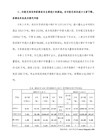
高级律师 senior lawyer
各类协议和合同 agreements and contracts
公安局 Public Security Bureau
公司上市 company listing
公诉案件 public-prosecuting case
法学院 law school
法院公告 court announcement
反诉状 counterclaim
房地产律师 real estate lawyer; real property lawyer
非合伙律师 associate lawyer
非诉讼业务 non-litigation practice
合伙制律师事务所 law office in partner-ship; cooperating law ofice
合同审查、草拟、修改 contract review, drafting and revision
会见当事人 interview a client
会见犯罪嫌疑人 interview a criminal suspect
调查笔录 investigative record
调查取证 investigation and gathering for evidence
调解 mediation
调解书 mediation
二审案件 case of trial of second instance
发送电子邮件 send e-mail
出差 go on errand; go on a business trip
出国深造 further study abroad
应诉通知书英文
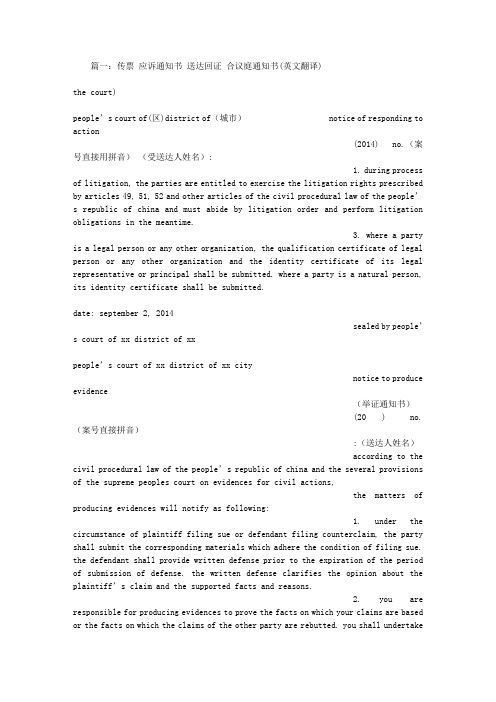
篇一:传票应诉通知书送达回证合议庭通知书(英文翻译)the court)people’s court of(区)district of(城市) notice of responding to action(2014) no.(案号直接用拼音)(受送达人姓名):1. during process of litigation, the parties are entitled to exercise the litigation rights prescribed by articles 49, 51, 52 and other articles of the civil procedural law of the people’s republic of china and must abide by litigation order and perform litigation obligations in the meantime.3. where a party is a legal person or any other organization, the qualification certificate of legal person or any other organization and the identity certificate of its legal representative or principal shall be submitted. where a party is a natural person, its identity certificate shall be submitted.date: september 2, 2014sealed by people’s court of xx district of xxpeople’s court of xx district of xx citynotice to produce evidence(举证通知书)(20 ) no. (案号直接拼音):(送达人姓名)according to the civil procedural law of the people’s republic of china and the several provisions of the supreme peoples court on evidences for civil actions,the matters of producing evidences will notify as following:1. under the circumstance of plaintiff filing sue or defendant filing counterclaim, the party shall submit the corresponding materials which adhere the condition of filing sue. the defendant shall provide written defense prior to the expiration of the period of submission of defense. the written defense clarifies the opinion about the plaintiff’s claim and the supported facts and reasons.2. you are responsible for producing evidences to prove the facts on which your claims are based or the facts on which the claims of the other party are rebutted. you shall undertakethe adverse consequence, if you failed to submit evidence materials or submitted evidences is failure to the fact which you provide to the court.3. evidences submitted by the parties to the people’s court shall be the originals, or original objects; if you keep the originals or it is difficult to provide the originals, you may provide copies or replicas checked and found in conformity with the originals by the people’s court. the submitted evidence materials shall be classified and numbered one by one. it is required to briefly describe the sources, facts to be proved and contents of the evidence materials. after being numbered, signature and seal shall be in place. it shall indicate the date of submission. copies shall be provided according to the number of the parties of the opposing side. the submitted written evidence, except the originals, shall be in the form of a4 paper of international standard.4. if meet one of the conditions of article 17 of the several provisions of the supreme peoples court on evidences for civil actions, the parties shall submit written application to the court seven days prior to the expiration of evidence producing period for investigation and collection of evidence. the application shall clearly state the name or work unit, address and other basic information of the person under investigation, the contents of the evidence that needs investigation and collection, reason for the people’s court to investigate and collect the evidence and facts to be proved.5. the parties shall submit written application for preservation of the evidence seven days prior to the expiration of evidence producing period. the court may require relevant guarantee from your side according to the situation. for cases to whichsummary procedure is applied, the time of application of the parties shall not be subject to the restriction of seven days.6. the parties shall apply expert evaluation, additional claim, claim modification or counterclaim prior to the expiration of evidence producing period.7. the parties shall submit application to the court for witness testimony in court ten days prior to the expiration of evidence producing period. with the approval of the court, witness shall give testimony in court and accept interrogation. for cases to which summary procedure is applied, the time of application of the parties shall not be subject to the restriction of ten days.8. upon receiving the notice, you may consult the evidence producing period with the other party before applying recognition from the court.you shall submit evidence to the court within thirty days from the following day of receiving the notice if you and the other party fail to reach agreement or apply recognition from the court,or the court does not provide recognition.9. if it is truly difficult to present evidence and material during the evidence producing period, you shall submit written application to the court for extension according to article 36 of the several provisions of the supreme peoples court on evidences for civil actions.10. it shall be deemed that you withdraw the right of producing evidence if the evidence submitted by you during the evidence producing period does not meet the “new evidence” rule prescribed by article 41, section 2 of article 43 and article 44 of the several provisions of the supreme peoples court on evidences for civil actions, unless the other party agrees to cross-examination.date: september 2, 2014 sealed by people’s court of xx district of xxpeople’s court of xx district of xxreceipt of deliveryissued by: (签发人) delivered by: (送达人)sealed by people’s court of xx district of xxnote: 1. the delivery of criminal procedure documents shall be in accordance with article 57 of criminal procedure law; the delivery of civil procedure documents shall be in accordance with article 78 and article 79 of civil procedure law. 2. the person designated to received documents shall sign or seal on the paper. the relationship between the person to be served and the person designated to received documents as well as reasons for the designation shall be clarified.篇二:应诉通知书×××劳动争议仲裁委员会应诉通知书(存根)×劳仲案字〔〕第号:本委决定受理与你(单位)…………………(写明主要的争议原因)劳动争议一案,现依照《中华人民共和国劳动争议调解仲裁法》的有关规定,将有关事项通知如下:一、请你(单位)在送达回执上签收本通知,申诉书副本及有关的仲裁文书。
法律英语词组(期末)
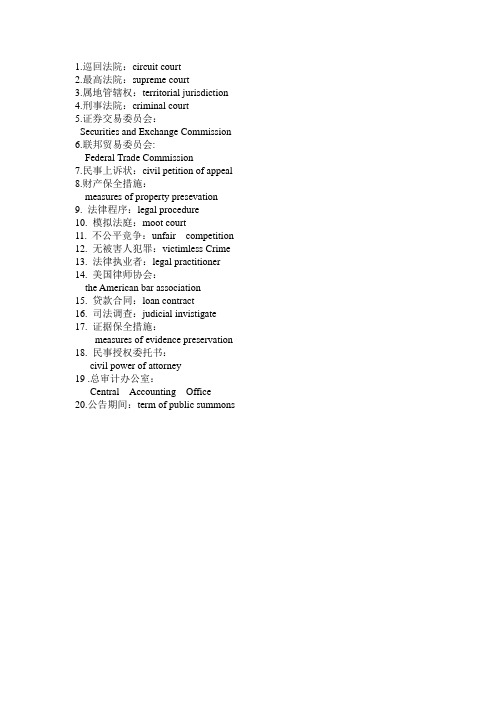
1.巡回法院:circuit court2.最高法院:supreme court3.属地管辖权:territorial jurisdiction4.刑事法院:criminal court5.证券交易委员会:Securities and Exchange Commission 6.联邦贸易委员会:Federal Trade Commission7.民事上诉状:civil petition of appeal8.财产保全措施:measures of property presevation9. 法律程序:legal procedure10. 模拟法庭:moot court11. 不公平竞争:unfair competition12. 无被害人犯罪:victimless Crime13. 法律执业者:legal practitioner14. 美国律师协会:the American bar association15. 贷款合同:loan contract16. 司法调查:judicial invistigate17. 证据保全措施:measures of evidence preservation 18. 民事授权委托书:civil power of attorney19 .总审计办公室:Central Accounting Office 20.公告期间:term of public summons1.简易审判庭:court of summary jurisdiction2.起诉状副本: copy of a bill of complaint3.税务法院: tax courts4.上诉法院: courts of appeals5.行政机构 :Executive Branch6.民事判决书 : the civil Judgment7.律师资格考试: bar examination8.司法道德准则 :canons of judicial ethics9.速达传票 : short summons10.刑事被告: criminal defendant11.商业信誉: business prestige12.小陪审团: petit jury13.联邦宪法:the United States Constitution14.社会革命: social revolution15.律师事务所:law offices16.私立学校:private school17.消费者产品安全委员会:the Consumer Products Safety Commission 18.基础设施委员会:infrastructure committee19.审前会议:pretrial conference20.成文法解释: :statutory interpretation1公共利益:public interest2.众议院:the house of representatives3.参议院:the senate4.立法机构:Legislative Branch5.应诉通知书:notice of respondence to action6.诉讼义务:litigious obligation7.中级人民法院:intermediate people's court8.司法部:the Departments of Justice9.国防部:the Departments of Defense10.国务院:the Departments of states11.行业标准:industry norm12.重大过失:gross negligence13.交通法规:traffic code14.宪法制度:constitutional system15.宪法权利:consititution right16.担保公司:gurantee of insurance17.债的担保:gurantee of obligation/debt18.犯罪构成:consititution of crime19.初审:trial of first instance20.终审:trial of final instance。
